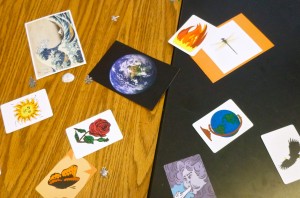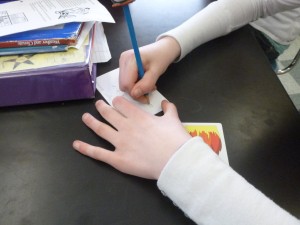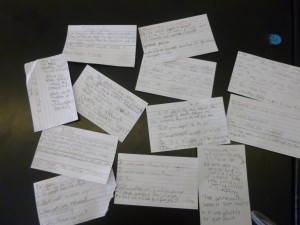Mar 12, 2013 Creating Context, Inspiring Inquiry, and Building Community: Another Variation of Trade and Share
In the last couple of posts I’ve been offering variations of “Trade and Share” an icebreaker or group building activity “upcycled” or re-purposed both as a reflective technique and as an interactive way to review and explore academic content. In today’s post I share another example of using this group building and dialogue activity to create context, inspire inquiry into a subject, and facilitate formative assessment. As Jessica Dubie showed us last week, variations of this technique could be used in a variety of training, teaching, and group facilitation applications.
In my ongoing work with teachers and students at Twin Valley Middle School we regularly experiment with experiential ways to increase engagement and deliver and reinforce academic content while practicing social-emotional skills and building a positive and supportive learning community. Recently, my colleague Jessica Hammond a science teacher at TVMS asked if we could try something to draw students into the unit she was starting on the earth’s atmosphere. Her hope was to inspire thinking around how the atmosphere affects students and the life around them.
 We facilitated this activity on the second day of the unit after Jessica had briefly introduced the basics of the topic. I selected an assortment of my Pick-a-Postcards, Chiji Cards, and Miniature Metaphors with a variety of representations of living creatures, plants, and natural phenomena such as snow flakes, sun, rain etc. We laid the objects and images out on lab tables. As students entered the room we asked them to choose an object or image they were drawn to. We then handed everyone an index card. As with other object based entry tasks, students were immediately drawn into the lesson from the moment they walked into class.
We facilitated this activity on the second day of the unit after Jessica had briefly introduced the basics of the topic. I selected an assortment of my Pick-a-Postcards, Chiji Cards, and Miniature Metaphors with a variety of representations of living creatures, plants, and natural phenomena such as snow flakes, sun, rain etc. We laid the objects and images out on lab tables. As students entered the room we asked them to choose an object or image they were drawn to. We then handed everyone an index card. As with other object based entry tasks, students were immediately drawn into the lesson from the moment they walked into class.
 Jessica and I then asked students to take a moment and think about their object or picture (representing items such as a sea turtle, tree, flower, bird, snowflake, sun, butterfly, ocean wave, etc.) and what they know about how it interacts with the earth’s atmosphere. We asked them to write down three things:How their animal or plant affects the atmosphere, how their item is affected by the atmosphere and finally, any question(s) they have about this how creature or phenomena interacts with the atmosphere.
Jessica and I then asked students to take a moment and think about their object or picture (representing items such as a sea turtle, tree, flower, bird, snowflake, sun, butterfly, ocean wave, etc.) and what they know about how it interacts with the earth’s atmosphere. We asked them to write down three things:How their animal or plant affects the atmosphere, how their item is affected by the atmosphere and finally, any question(s) they have about this how creature or phenomena interacts with the atmosphere.
We then went through the trade and share sequence described in previous posts. In this variation we asked them to take time during each partner object trade to add notes from their discussion with their partner to the index card, and then send the index card with the object to the next partner. For example, for each trade they might add an additional bit of knowledge that came up in their conversation with their partner around how their item interacts with the atmosphere. Or, after talking with their partner they might add another question about how that creature or natural phenomena and the atmosphere interact.
After two to three trades we invited students to come back the center of the room in a circle to share the cards. Students went around the circle and shared what item they ended up with, what knowledge was collectively shared about its interaction with the earth’s atmosphere, and finally any questions that participants added to the card.
There were a number of positive outcomes from this activity. It became a formative assessment for Jessica and the students to understand what their base knowledge of the earth’s atmosphere was at the beginning of the unit. An extensive list of questions was generated by students about the atmosphere and how it interacts with and affects life on earth. It seemed to spark student’s interest in exploring the subject further. This activity also became another important opportunity to practice social-emotional and community building skills such as interacting with people outside of one’s friend group, and practicing pro-social communication and problem solving. We might try this again at the end of the unit as a summative assessment!
Hopefully this series of posts on variations of “Trade and Share” variations will inspire you to think of how some of your favorite ice-breakers or rapport building activities can be “upcycled” for review and reflection. Please share your thoughts or inspiration!



No Comments